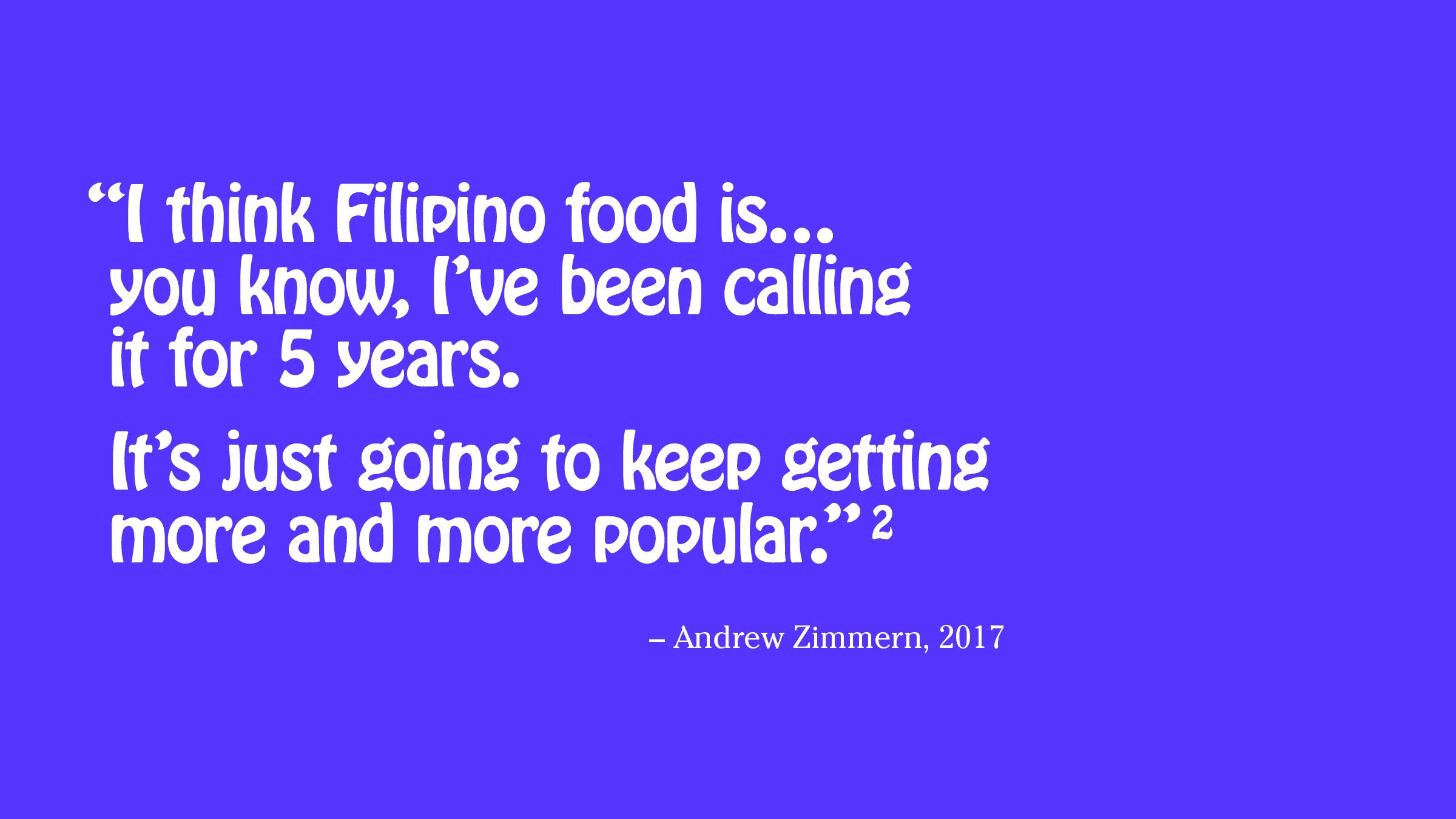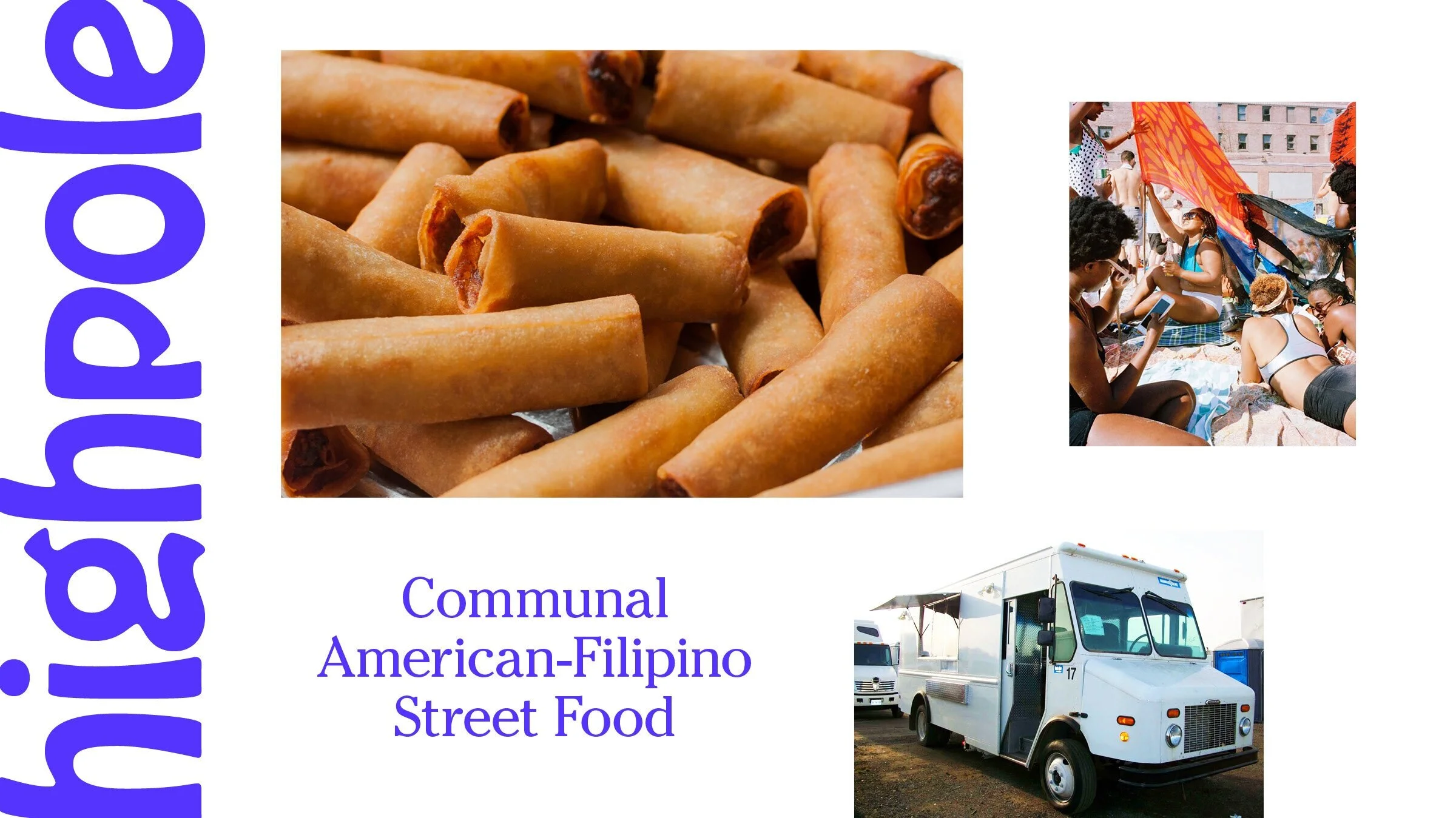
Highpole
Communal American-Filipino street food
COMMUNAL AMERICAN-FILIPINO STREET FOOD
There have been predictions for Filipino food to take center stage in America for almost 10 years now. Back in 2017, Vogue declared that “Filipino food is becoming the next great American cuisine,”1 five years after Andrew Zimmern predicted Filipino cuisine was “going to keep getting more and more popular.”2 While there have been more inroads to the mainstream, there still isn’t a fully saturated market here in the United States. I see this as an opportunity to draw from the food of my personal and familial racial heritage while taking advantage of this space in the market.
As a biracial Filipino-American, food — especially being able to make lumpia, or Filipino eggrolls — has always been something that I lean on as proof of belonging when talking to other Filipino people. However, my mom’s white, my dad never pushed for me and my brother to really embrace our cultural heritage, and we didn’t grow up surrounded by a Filipino community. So when I was younger I often grappled with my racial identity, feeling pressure to pick one or the other before eventually deciding for myself what it means “to belong to a socially constructed category.”3 Within the food and restaurant industry, there’s a lot of emphasis on authenticity in ethnic restaurants that, for me, wavers between fetishizing and gatekeeping, depending on the author and the audience. With my street food concept, I’m interested in creating a space to both perform and process identity for myself and other mixed-race chefs.
I started using the email address highpole@gmail.com when I was 13, and I’ve had a pipe dream of starting a lumpia food truck since I was 18. This concept is very near and dear to my heart.
(Image credits: Yummly shrimp lumpia recipe, Naima Green, Food Truck for You)
Highpole is an American-Filipino food truck that sells communal portions of lumpia and weekly specials inspired or created by mixed-race guest chefs. The name is the American phonetic spelling of my last name; seeing as this food truck would be deeply personal to my own experience and my family’s cooking, I wanted its branding and identity to express my place as a native “other” within the United States.
Because Highpole specializes in communal portions, the trucks will be stationed at the entry points for large parks and beaches where groups of people gather for long periods of time and want to share food that isn’t messy and doesn’t require utensils. The core of the business will be three types of lumpia: my family’s chicken recipe, mushroom and shrimp. Even though my grandmother on my dad’s side passed down our family recipe to us, my mother is the one who taught me how to make it when I was in high school, and her tastes have influenced the flavors I gravitate towards and am familiar with. So, for me, making lumpia is an expression of my racial heritage as well as my upbringing, marrying both aspects of my background.
Tapow paper is a kind of waxy brown paper used in Singapore to package takeaway food.
(Image credit: Atelier Hoko for MOLD Magazine, Issue 4)
To encourage sharing and communal consumption, lumpia will be available in quantities of 5, 10 and 20. Each order will be wrapped in grease resistant, eco-friendly kraft paper sealed shut with a branded sticker to minimize packaging. The wrapping not only mirrors the process of wrapping lumpia, but also alludes to the table setting for a kamayan: “Tagalog for ‘by hand,’ kamayan is the traditional Filipino form of eating. But the term has also come to refer to a communal-style Filipino feast, composed of colorful arrays of food that are usually served on banana leaves and eaten without utensils.”4 My intention is for people to buy a large quantity to share so that when they open up the package the waxed kraft paper acts as a surface covering that takes the place of the traditional banana leaves. When communal food is housed in containers, I feel like there’s a threshold to cross and a sense of needing to ask the owner for permission before digging in. By eliminating physical barriers, I hope to eliminate the pressure of ownership and debt that can come from sharing food. I’ll also use naturally dyed paper to color code each type of lumpia to be sure that guests know which ones they’re about to eat. All additional sauces will be packaged in small, paper-based waxed cartons to avoid single-use plastics.
A diagram showing how to wrap lumpia.
(Image credit: Shelby Hipol)
In addition to the core offering of lumpia, I also want to serve a weekly special of Filipino dishes from around the different regions of the Philippines as well as from other Filipino communities in diaspora around the world. For the specials, I would love to host other mixed-race cooks (professional chefs and home cooks) to give them a space to celebrate and sell their food. And for other people who don’t necessarily want to work in the kitchen, I’ll host a regular podcast where we discuss our racial and cultural identities through the lens of food and cooking. Each episode’s guest would then be the inspiration for a new special. Because these specials will probably take a variety of forms, they will all be packaged in a single kind of compostable paper-based lidded bowl for simplicity and sustainability. If needed, the specials can include utensils made of sustainable materials like bamboo, but the lumpia is meant to be eaten by hand. All the chefs I host or collaborate with will receive 100% of the proceeds from their specials, and through social media and point-of-sale promotions I hope to help foster a community where I could support, promote and uplift other chefs who are also using food as a way to communicate their identities.
Because I’m mixed race and didn’t grow up with a strong connection to my Filipino heritage, I feel like it would be inappropriate for me to start an “authentic” Filipino food truck. However, cooking and serving lumpia in communal portions reminds me of my childhood and my grandmother and the karaoke parties my parents used to host, and it feels like an authentic entry point for me to share and discuss identity with my Filipino and mixed contemporaries. Through Highpole, I want to use cooking as a way to foster community and talk about personal and cultural identity — both for myself and for the people eating my food.
A kamayan is typically a communal-style feast served on banana leaves and eaten without utensils.
(Image credit: SOMA, San Francisco)





